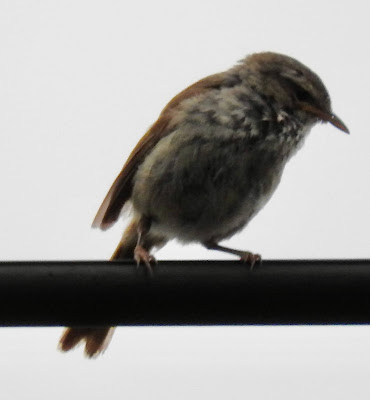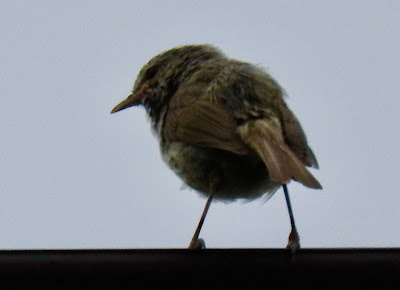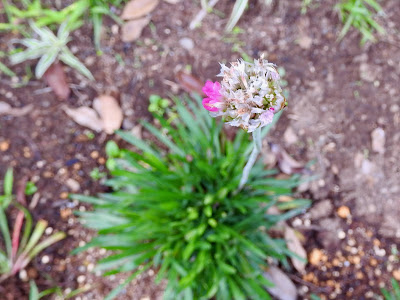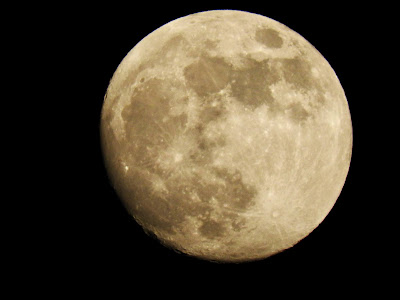目次 / Contents
1) 羽を持つもの / Those With Wings
A .鶯 / Japanese Bush Warbler
B. 午後 / Afternoon
C. チヌーク / Chinook
2) それぞれの成長 / Each Growth
3) 月の名前 / Names of Moon and Month
A. 6月23日の月 / Moon on 23rd of June
B. 月とシーズン / Month, Moon and Season
1) 羽を持つもの / Those With Wings
A .鶯 / Japanese Bush Warbler
今まで鶯は、声はしても姿が見えず、撮影ができませんでした。
ところが、今年は我が家の前の電線で、毎朝、鳴いてくれる鶯がいます。
私のカメラのズーム限界まで使うと撮影できます。
なので写真の出来は良くないけれど、嬉しがって撮影しています。
鶯は声の魅力に比べると外見は地味と思っていましたが、写真をPCで見ると可愛らしい様子がわかり、以前よりずっと外見も可愛く感じます。
 |
| おはよう! / Good Morning! |
Japanese Bush Warbler
Nowadays I take photographs of Japanese Bush Warbler almost every day.
Until recently, Warbler couldn't be photographed because he cannot be seen even when he sings.
However, this year there is a warbler that sings every morning on a cable in front of our house.
I can photograph with my camera at the zoom limit.
So the photographs aren't good, but I'm happy to take them.
I thought that Warbler looked sober compared to the charm of his voice, but when I look at the photographs on my PC, I can see how cute he looks, and it feels much more lovely than before.
 |
| 後ろ姿 (写真内) で、鳴いていることがわかるようになりました。 I can now see from his back in the photograph if he is singing.  |
 |
| かわいい顔 こちらを向くことが少ないので、この写真は珍しい! Cute Face This photo is rare because he rarely looks this way! |
 |
| 右見て! / Look Right! |
 |
| 左見て!/ Look Left! |
 |
| また右見て! / Look Right Again! |
 ホーホケキョ! |
| 珍しくこちら側に向かって鳴いてくれています。 Hohokekyo! Unusually, he sings this way. |
In Japan, when we were children and cross a pedestrian crossing, we were taught,
"Look Right, Look Left, Look Right Again, If all clear, Cross!"
I made sentences here with this common sense, this is a little playful.
 |
| ホーホケキョ! / Hohokekyo! |
 |
| 現在日本では鳥獣保護法により捕獲・飼育が 禁止されています。 Currently in Japan, capture and breeding of Uguis : Japanese Bush Warbler are prohibited by Protection and Control of Wild Birds. |
B. 午後 / Afternoon
午後に家の窓から鶯の声を録画しました (下)。
こちらは姿が見えず、声だけです。
朝の鶯と同じなのかはわかりません。
朝の鶯と比べると遠くにいるように感じます。
Afternoon
In the afternoon, I recorded a song of a warbler from the window of our house, above.
He cannot be seen, just his song.
I don't know if it's the same as the morning warbler.
He is far away compared to the morning warbler...I feel.
C. チヌーク / Chinook
 |
| チヌーク (陸上自衛隊・チヌーク : CH-47JA) 詳細はここで→★ / ★ 最近定期的にチヌークが行き来しています。 これは午後1時前。 お疲れ様です。 Chinook (Japan Ground Self-Defense Force's Chinook : CH-47JA) Click here for details → ★ Recently, Chinooks have come and gone regularly. This is before 1 pm. Thank you for your hard work. |
2) それぞれの成長 / Each Growth
 |
| ジャイアントホスタの花 私は、'花のドローイング' 用に庭の花を切りますが、 これは切ることができません。 Giant Hosta Flowers I cut flowers in our garden for 'Flower Drawing', but I can't cut these.  |
 |
ホワイト・ロビリア (スノー・ホワイト・スノー) ホワイト・ロベリアは、切り戻し後、元気に再び咲いています。 White Lobelia (Snow White Snow) After cutting back, Lobelia is in full bloom again. |
 |
| ホワイト・ランタナとスペアミント ホワイト・ランタナとスペアミントは同じ鉢に植っていましたが、 夫Rがそれぞれの鉢に植え替えました。 White Lantana and Spearmint White Lantana and Spearmint were planted in the same pot, but my husband R replanted them in their respective pots.  スペアミント スペアミントは、2つの苗があるので2つの鉢に植えてあります。 雑草のように成長すると聞いて別々にしました。 そんなふうに成長することを期待しています。 我が家のスペアミントを使ってモヒートを作ってみたいです。 Spearmint Spearmint is planted in two pots because it has two seedlings. I heard that it grows like weeds and separated them. I hope that it will grow like that. I would like to make a Mojito using our spearmint. |
 |
| ジャスミンの蕾 蕾はピンクが混じっていますが、咲く花は真っ白です。 少女から淑女に変化するようなイメージがします。 Jasmine Buds The buds are mixed with pink, but the blooming flowers are pure white. I have the image of changing from a girl to a lady. |
 |
| マーガレット かなりの切り戻し後、再び咲き始めました。 Margarite After a considerable cutback, it began to bloom again.  |
 |
| オリヅルラン オリヅルラン (折鶴蘭)の花が咲き始めました。 こんなに綺麗な花であったことを今まで気が付きませんでした。 和名のオリヅルランは美しい響きですが、 英名はスパイダー・プランツ(Spider Plant):蜘蛛の植物と言い、 ネガティヴな印象です。 Spider Plant : Orizururan The flowers of Spider Plant have begun to bloom. I have never noticed that it was such a beautiful flower. Japanese name, Orizururan comes from Orizuru : Paper Crane. For me, the Japanese name sounds beautiful, it is different from the English name. |
 |
| ランタナ ランタナの和名はシチヘンゲ (七変化)。 和名の通り、花のいろが次々に変化してゆきます。 形も面白く興味深い植物です。 Lantana The Japanese name for Lantana is Shichihenge (seven changes). As the Japanese name suggests, its flowers change colour one after another. It is also an amusing shape, it is an interesting plant.  |
 |
| レモンマートル レモンマートルの葉を切り、揉むと、 レモンの香りに似たとても良い香りがします。 料理にも使用できるそうですが私はまだ使ったことがありません。 使用は風呂に入れただけです。 今年は元気が良いようなので、 お料理にも使用してみたいと思います。 Lemon Myrtle When I cut and knead the leaves of Lemon Myrtle, it has a very good scent, similar to the scent of Lemon. I heard that it can be used for cooking, but I haven't used it yet. I just put it in the bath. This year, this seems to be fine, so I would like to use it for cooking. |
 |
| 大好きな一角 ここを何度も撮影していますが、 また撮影してしまいます。(笑) Favorite Corner I've been photographing here many times, but I would photograph again. (Laugh) |
 |
| アルメニア アルメニアの花の季節は終わったかと思った後に 1つすくすくと成長していました。 もうすぐ花が咲くと言うところで雨にあたり 健康的に咲くことができませんでした。 Armenia After I thought the Armenia flower season was over, only this one was growing well. However, when the flower was about to bloom, it was raining and this couldn't bloom healthily.  かわいそうな感じ... / Poor thing... |
3) 月の名前 / Names of Moon and Month
A. 6月23日の月 / Moon on 23rd of June
B. 月とシーズン / Month, Moon and Season
和風月名 (詳細はこちら→★)
Japanese Traditional Month Names : ★ (Only in Japanese)
1月Jan. 睦月 / Mutsuki
正月に親類一同が集まる、睦び(親しくする)の月。
2月Feb. 如月 / Kisaragi
衣更着(きさらぎ)とも言う。
まだ寒さが残っていて、衣を重ね着する(更に着る)月。
3月Mar. 弥生 / Yayoi
木草弥生い茂る(きくさいやおいしげる、草木が生い茂る)月。
4月Apr. 卯月 / Uzuki
卯の花の月。
5月May. 皐月 / Satsuki
6月Jun. 水無月 / Minazuki, Minatsuki
水の月(「無」は「の」を意味する)で、田に水を引く月の意と言われる。
7月Jul. 文月 / Fumizuki, Fuzuki
稲の穂が実る月(穂含月:ほふみづき)
8月Aug. 葉月 / Hazuki, Hatsuki
木々の葉落ち月(はおちづき)。
9月Sep. 長月/ Nagatsuki, Nagazuki
夜長月(よながづき)。
10月Oct. 神無月/ Kannazuki
神の月(「無」は「の」を意味する)の意味。全国の神々が出雲大社に集まり、各地の神々が留守になる月という説などもある。
11月Nov. 霜月 / Shimotsuki
霜の降る月。
12月Dec. 師走 / Shiwasu
師匠といえども趨走(すうそう、走り回る)する月。
(和風月名の月は、旧暦を元にしているので、現在の季節感とは
1~2ヶ月ほどのずれがあります。)
(Since Japanese traditional month names : Wafuumeigetsu are based on Lunar Calendar : Old Calendar, there is as a difference of about 1 to 2 months from the current sense of the seasons.)
北アメリカのネイティブ・アメリカンの満月の名前
下記は、"満月カレンダー"からの引用です。
"1月・ウルフムーン
真冬の寒さと深い雪の中、ネイティブ・アメリカンの村の外では狼の群れが飢えた声で吠えていました。
2月・スノームーン
この月は大雪になることが多いため、北欧や東欧の先住民は2月の
満月を「雪の満月」と呼んでいました。
3月・ワームムーン
気温が上昇して地面が解け始めると、ワーム(ミミズ)が現れ、
コマドリが戻ってくることを知らせてくれます。
4月・ピンクムーン
この名前は、春の最も早い時期に広く見られる花の一つである
クサキョウチクトウに由来します。
5月・フラワームーン
ほとんどの場所で、この季節にはどこにでもたくさん花が咲いているので、5月はフラワームーンです。
6月・ストロベリームーン
毎年6月はイチゴの収穫期が比較的短いため、その月の満月を
「イチゴの月」と命名しました。
7月・バックムーン
7月は例年、バック(雄鹿)の新しい角がビロードのような毛に覆われて額から押し出される月です。
8月・スタージョンムーン
よく獲れる月であったことから、漁師の部族が命名しました。
9月・コーンムーン
ネイティブ・アメリカンはこの時期に、コーン(トウモロコシ)を
収穫していました。
ハーベストムーンとも呼ばれています。
10月・ハンターズムーン
木々の葉が落ち、動物がこれから始まる長い冬に備えて肉を蓄える
時期です。
稲刈りの終わった畑に落ちた穀物に、キツネなどがやってきます。
11月・ビーバームーン
沼が凍る前にビーバーの罠を仕掛け、暖かい冬の毛皮を確保する時期だったのです。
12月・コールドムーン
この月は、冬の寒さが厳しくなり、夜が最も長く、暗くなります。"
月を見ると情緒感や想像力が刺激されるのは、伝統的に、もしくは
細胞的に、季節の不思議さや畏怖を感じるからなのかもしれません。
 |
| クサキョウチクトウ 'ピンクムーン' の名の由来のクサキョウチクトウ (草夾竹桃)。 和名の"クサキョウチクトウ"は、 明治時代から使用されていますが、 実はキョウチクトウ科とは関係がありません。 Garden Phlox Garden Phlox is the origin of the name 'Pink Moon'. 画像は下記より / This from below ★ |
Month and Season
North American Native American Full Moon Names.
According to "Full Moon Calendar" only in Japanese.
(Translated by me)
"January ・Wolf Moon
In the cold of midwinter and deep snow, a flock of wolves barked in a hungry voice outside the Native American village.
February ・Snow Moon
Indigenous peoples of Northern and Eastern Europe called the full moon of February the 'Snow Moon' because it often snows heavily this month.
March ・ Worm Moon
When the temperature rises and the ground begins to thaw, Worm (Earthworm) appears, signaling that Robin is returning.
April ・Pink Moon
The name comes from Garden Phlox, one of the most widely seen flowers in early spring.
May ・Flower Moon
May is the Flower Moon, as most places have lots of flowers everywhere during this season.
June ・Strawberry Moon
Since the strawberry harvest season is relatively short in June every year, we named the full moon of that month
'Strawberry Moon'.
July ・ Buck Moon
Every year in July, new horns on the buck (stag) are covered with velvety hair and pushed out of the forehead.
August ・ Sturgeon Moon
It was named by the fishermen's tribe because it was the month when Sturgeon, a large fish that lives in the Great Lakes, was most often caught.
September ・Corn Moon
Native Americans were harvesting corn during this time.
Also known as Harvest Moon.
October・Hunters Moon
It's time for the leaves to fall and the animals to store meat for the upcoming long winter.
Foxes and other animals come to eat the grains that have fallen in the fields where the rice has been harvested.
November ・Beaver Moon
It was time to set up a beaver trap and secure warm winter fur before the swamp froze.
December ・ Cold Moon
This month is the coldest of winters, with the longest and darkest nights."
Looking at the moon stimulates emotions and imagination, it might be because we feel the mystery and awe of the seasons, traditionally or cellularly.





0 件のコメント:
コメントを投稿